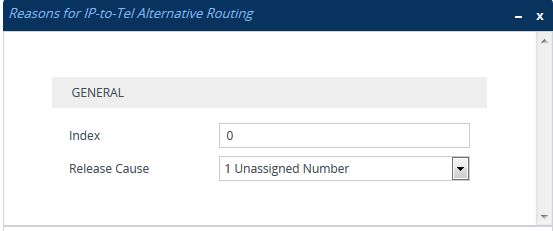Alternative Routing to Trunk upon Q.931 Call Release Cause Code
You can configure up to 10 ISDN Q.931 release cause codes. If the device receives a configured release cause code from the Tel side, it routes the IP-to-Tel call to an alternative Trunk Group, if configured.
Alternative IP-to-Tel routing rules are configured in the IP-to-Tel Routing table. These rules must be configured anywhere below the "main" routing rule and with identical matching characteristics (e.g., destination prefix number) to the "main" routing rule. The device uses the first alternative route that is available. For more information on configuring alternative IP-to-Tel routing rules in the IP-to-Tel Routing table, see Configuring IP-to-Tel Routing Rules.
A release cause code indicates that the IP-to-Tel call has been rejected or disconnected on the Tel side. The release cause codes are configured in the Reasons for IP-to-Tel Alternative Routing table. For example, you can configure alternative IP-to-Tel routing for scenarios where the initial Tel destination is busy and a Q.931 Cause Code No. 17 is received (or for other call releases that issue the default Cause Code No. 3).
You can configure a default release cause code that the device issues itself upon the following scenarios:
|
■
|
The device initiates a call release whose cause is unknown. |
|
■
|
No free channels (i.e., busy) in the Trunk Group. |
|
■
|
No appropriate routing rule located in the IP-to-Tel Routing table. |
|
■
|
Phone number is not located in the IP-to-Tel Routing table. |
The default release code is Cause Code No. 3 (No Route to Destination). You can change the default code as follows:
|
➢
|
To change the default Q.931 release code: |
|
1.
|
Open the Gateway Advanced Settings page (Setup menu > Signaling & Media tab > Gateway folder > Gateway Advanced Settings). |
|
2.
|
In the 'Default Release Cause' field, enter the release cause code: |

|
●
|
If a Trunk is disconnected or not synchronized, the device issues itself the internal Cause Code No. 27. This cause code is mapped (by default) to SIP 502.
|
|
●
|
The default release cause is described in the Q.931 notation and translated to corresponding SIP 40x or 50x values (e.g., Cause Code No. 3 to SIP 404, and Cause Code No. 34 to SIP 503). |
The following procedure describes how to configure alternative routing reasons for IP-to-Tel calls through the Web interface. You can also configure it through ini file [AltRouteCauseIP2Tel] or CLI (configure voip > gateway routing alt-route-cause-ip2tel).
|
➢
|
To configure alternative Trunk Group routing based on Q.931 cause codes: |
|
1.
|
Open the Routing Settings page (Setup menu > Signaling & Media tab > Gateway folder > Routing > Routing Settings). |
|
2.
|
From the 'Redundant Routing Mode' drop-down list, select Routing Table so that the device uses the IP-to-Tel Routing table for alternative routing: |

|
3.
|
Open the IP-to-Tel Routing table, and then configure alternative routing rules with the same call matching characteristics as the "main" routing rule, but with different Trunk Group destinations. |
|
4.
|
Configure Q.931 cause codes that invoke alternative IP-to-Tel routing: |
|
a.
|
Open the Reasons for IP-to-Tel Alternative Routing table (Setup menu > Signaling & Media tab > Gateway folder > Routing > Alternative Routing Reasons > Reasons for IP > Tel). |
|
b.
|
Click New; the following dialog box appears: |

|
c.
|
Configure a Q.931 release cause code for alternative routing according to the parameters described in the table below. |
Reasons for IP-to-Tel Alternative Routing Table Parameter Descriptions
|
|
|
|
'Index'
[Index]
|
Defines an index number for the new table row.
Note: Each row must be configured with a unique index.
|
|
'Release Cause'
rel-cause
[ReleaseCause]
|
Defines a Q.931 release code that if received, the device attempts to route the call to an alternative destination (if configured).
|


